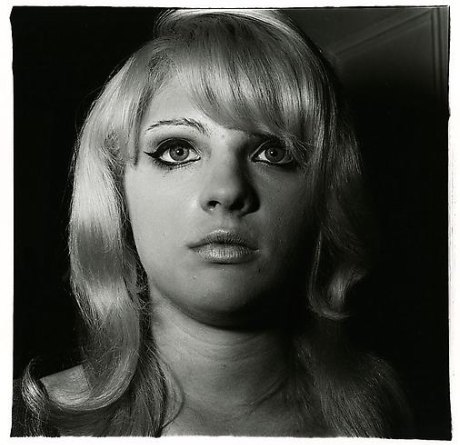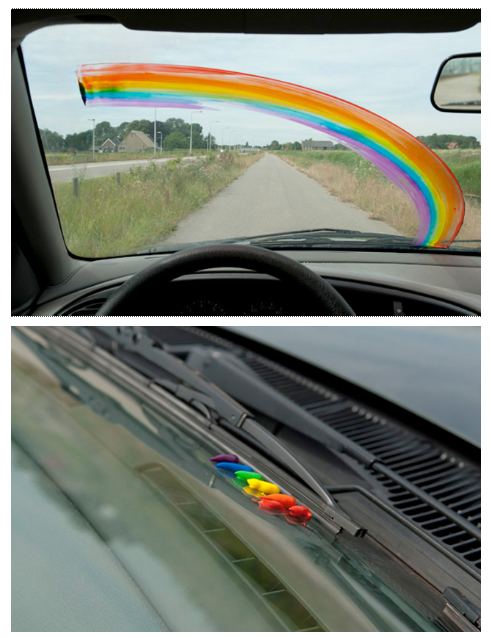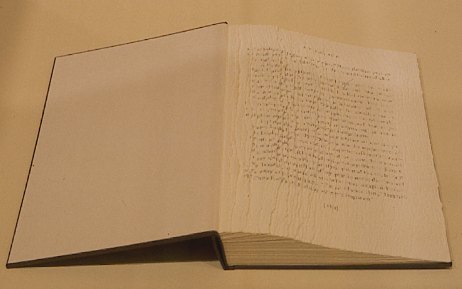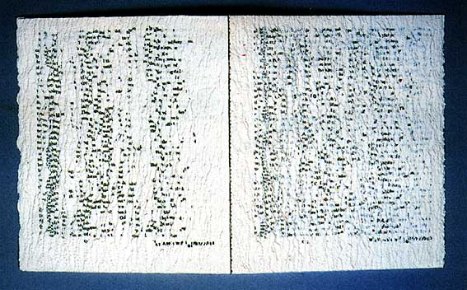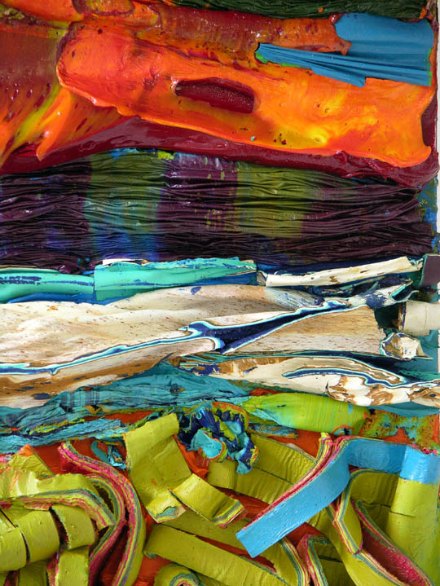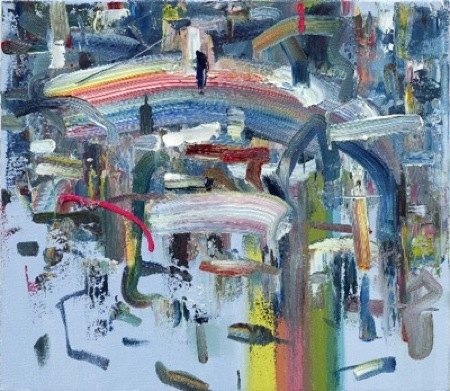Archives for July 2010
A reader’s waking nightmare
From Oliver Sacks, A Neurologist’s Notebook, A Man of Letters, The New Yorker, June 28, 2010:
On the morning of July 31, 2001, Canadian novelist Howard Engel awoke and discovered that he could not read the newspaper. His room looked normal, and he could still read his clock, but his books were all unintelligible….
Buzz Spector (second Spector image via)
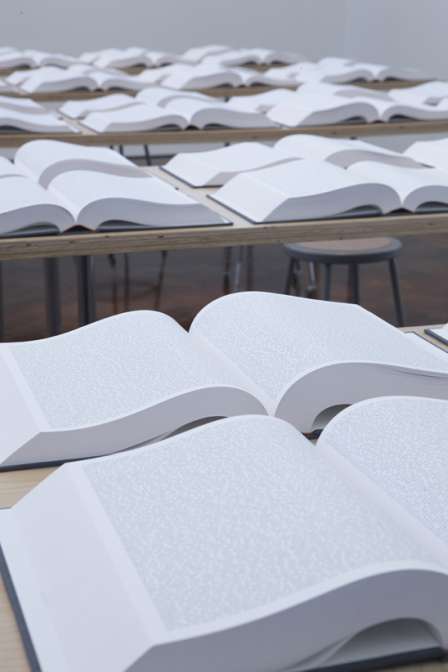
Painting, pound for pound
The heavyweight in the field is Jay DeFeo’s The Rose (1958-66), tipping the scale at 3,000 pounds. DeFeo didn’t intend gargantuan. Over the years, as she added and never took away, it grew. Most painters are content to work with a flat surface, but there are artists for whom flat is a synonym for starting gate. Once they blow through it, they go for volume, volume, volume.
 Peter Fox (via)
Peter Fox (via)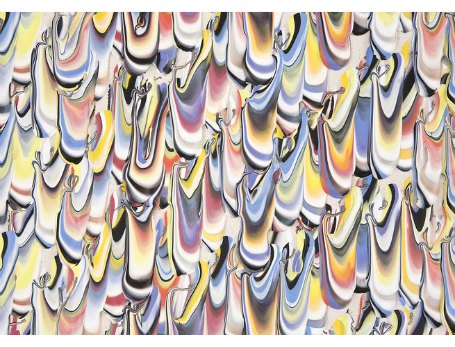 Margie Livingston
Margie Livingston
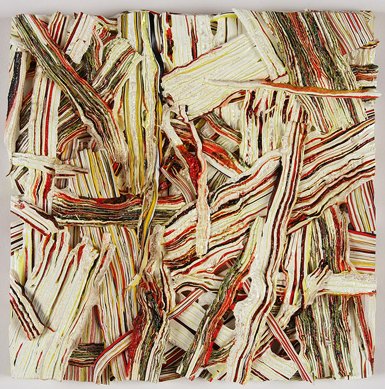 Peter Tollens Untitled
Peter Tollens Untitled
2005
oil on wood
3.75 x 3 inches
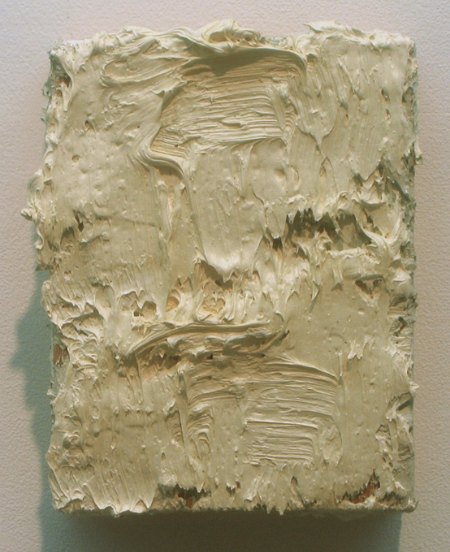 Michael Toenges
Michael Toenges
16-07-32-28
2007
oil on linen
15 x 13 inches
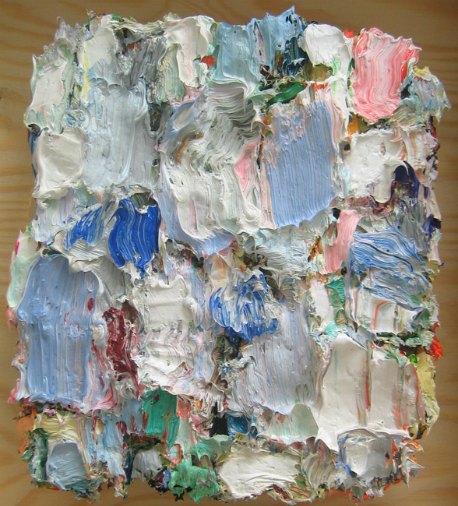 Andrew Dadson To Be Titled, 2010.
Andrew Dadson To Be Titled, 2010.
Oil on canvas
20 x 15 inches
(detail)
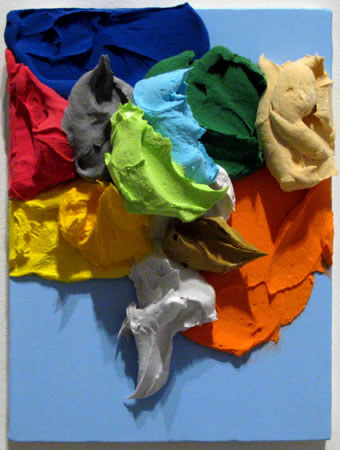 Tomory Dodge Survivalist, 2007. Oil on canvas.13 3/4 x 16 inches
Tomory Dodge Survivalist, 2007. Oil on canvas.13 3/4 x 16 inches
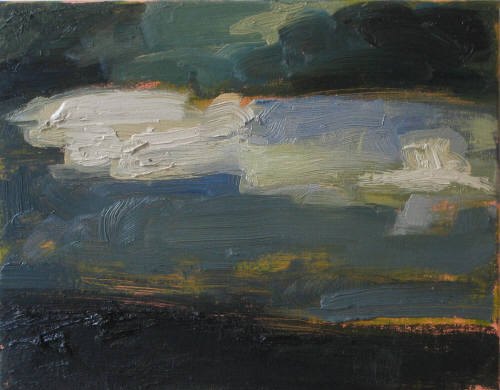 Joan Snyder Life of A Tree, 2007.
Joan Snyder Life of A Tree, 2007.
Oil, acrylic, cloth, berries, paper mache, glitter, nails, pastel, on linen
48″ x 68″
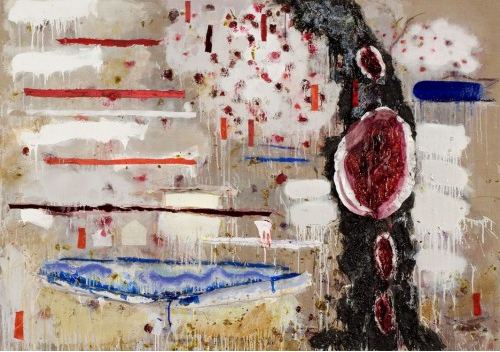 Alexander Kroll Untitled, 2009
Alexander Kroll Untitled, 2009
Oil on linen over panel
14″ x 14″
 Back to flat. Paint doesn’t need to be thick to be thick.
Back to flat. Paint doesn’t need to be thick to be thick.
Angela Fraleigh, in this moment, 2007, oil on panel, 72″ x 96″
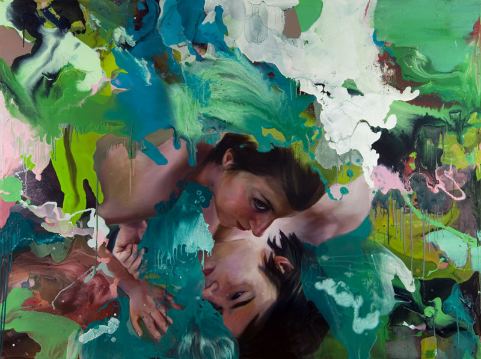
How Yeats echoes through our lives
Fallsapart is Sherman Alexie’s website address. Things Fall Apart is the title of Chinua Achebe’s masterpiece and also the title of the Mario Van Peebles’ upcoming film about a football player with cancer, starring 50 Cent.
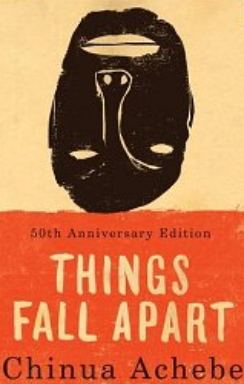 Slouching Towards Bethlehem is Joan Didion at her brilliant best. Dan Savage tips his hat to it in Skipping Towards Gomorrah.
Slouching Towards Bethlehem is Joan Didion at her brilliant best. Dan Savage tips his hat to it in Skipping Towards Gomorrah.
When law professor Elyn R. Saks wrote about her illness – “paranoid schizophrenia with acute exacerbation; prognosis: grave” – she titled it, The Center Cannot Hold. Paul Krugman went to the same well this morning to explain the problem with Obama:
Mr. Obama’s attempts to avoid confrontation have been counterproductive. His opponents remain filled with a passionate intensity, while his supporters, having received no respect, lack all conviction.
Everybody’s quoting William Butler Yeats, and not from the range of his work but from a single short poem published in 1919, The Second Coming. Nearly a century later, it has become the key to the millennial divide.
Turning and turning in the widening gyre
The falcon cannot hear the falconer;
Things fall apart; the centre cannot hold;
Mere anarchy is loosed upon the world,
The blood-dimmed tide is loosed, and everywhere
The ceremony of innocence is drowned;
The best lack all conviction, while the worst
Are full of passionate intensity.
Surely some revelation is at hand;
Surely the Second Coming is at hand.
The Second Coming! Hardly are those words out
When a vast image out of Spiritus Mundi
Troubles my sight: a waste of desert sand;
A shape with lion body and the head of a man,
A gaze blank and pitiless as the sun,
Is moving its slow thighs, while all about it
Wind shadows of the indignant desert birds.
The darkness drops again but now I know
That twenty centuries of stony sleep
Were vexed to nightmare by a rocking cradle,
And what rough beast, its hour come round at last,
Slouches towards Bethlehem to be born?
He even got the geography right. This is the problem with judging art by the artist. From his person – weak-willed, ineffective, given to flights of fancy (talks to faeries), holds grudges and doesn’t hit his stride till he’s past middle age – who would guess Yeats would become (on the basis of mere handful of poems) the most powerful writer in the English language since Shakespeare?
Update: James Harris reminded me of Lawrence Lemaoana from the gallery’s current show. (With admirable restraint, Harris did not add, How could you have forgotten this?)
Lawrence Lemaoana,
Things Fall Apart, 2009
Textile
49 x 32 inches
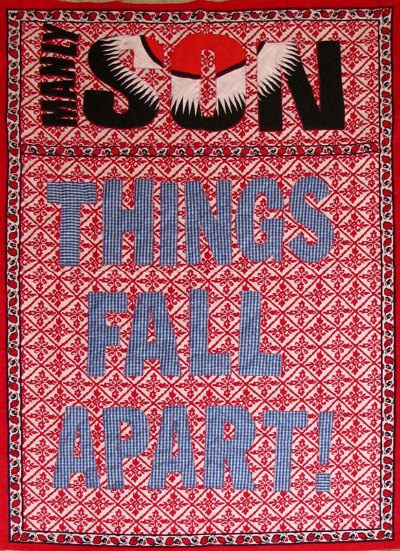
Jen Graves: discourse deterioration
Just as I feared. It’s not just Jerry Saltz. Bravo’s Work of Art is deteriorating the discourse. Jen Graves’ post on the last episode is devoted entirely to what she thinks of the artists’ personalities. She ended with:
May the winner not be a douchebag.
Jen. Shake your usually admirable head to clear it. We care about art, remember? Look down and check the color of your jersey. You’re on the art critic team. Art critics don’t care who’s a douchebag, not that they would would presume to judge based on the edited clips of a reality TV show. (My last posts on the show here and here.) The question is, who’s making the best art, as far as the audience can tell, given the format. It’s Miles Mendenhall followed by Peregrine Honig and Nicole Nadeau. They’re not necessarily the best artists, but they are the best reality TV artists this sorry season.
Work of Art & So You Think: Who’s fault?
Bravo’s Work of Art and Fox’s So You Think You Can Dance head for the finish line with opposite problems.
The former arrived at the gate packing a fatal flaw: Of the 14 candidates, at least 9 were unsuited to the format. Week after week, we’ve seen weak after weak. Last night Jerry Saltz woke up to the problem and started blaming the victims, hurling insults at the artists. This show does not represent contemporary art, artists or how people talk about art. And yet, yes, I’m watching it. (Tick, tick: the sound of me wasting my life.)
The latter, SYTYCD, opened with 10 terrific dancers and one struggling to keep up, Jose Ruiz. During the season, Ruiz accomplished the impossible. He transformed himself into a professional, not that the judges appear to have noticed. The real problem is the risk to the talent. Three are out with injuries. Of the six left standing, Billy Bell is nursing a knee injury, Ruiz pulled a groin muscle and Lauren Froderman was hospitalized last night with what early reports call dehydration. This year the show’s on speed-up, with dancers being asked for more and more daring-do by choreographers. Will SYTYCD become known as dance’s chain gang?
Appearing last night with Ade Obayomi in a Stacey Tookey piece about two childhood friends who bump into each other as adults, Bell was breathtaking. Watch him on the link.
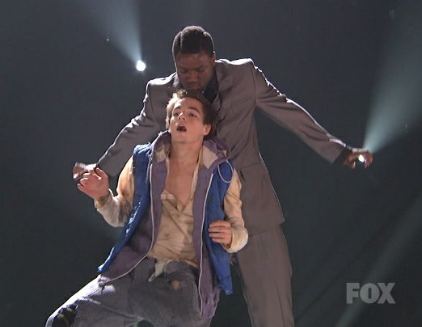 Work of Art does little for art, but SYTYCD has attracted a new generation of now passionate dance fans. Yes, it’s ham-fisted, but still glorious to watch.
Work of Art does little for art, but SYTYCD has attracted a new generation of now passionate dance fans. Yes, it’s ham-fisted, but still glorious to watch.
Open Satellite: I fear thee, ancient Mariner!
“Fear not, fear not, thou Wedding-Guest!
This body dropped not down.
Heather and Ivan Morison, Frost King at Open Satellite
 Some exhibits end early, even at major venues, earning from procrastinators lasting enmity. Rarer are the exhibits that trail behind their closure dates, still in place when they promised to be gone. They reward those who believe despite repeated evidence to the contrary that anytime they show up will be time enough.
Some exhibits end early, even at major venues, earning from procrastinators lasting enmity. Rarer are the exhibits that trail behind their closure dates, still in place when they promised to be gone. They reward those who believe despite repeated evidence to the contrary that anytime they show up will be time enough.
Curated by Eric Fredericksen, Heather and Ivan Morison‘s Storm King was supposed to end July 17. It’s still there, and there it will remain till after Aaron Flint Jamison‘s opening Aug. 11, 6-9 p.m. Yes, after. All the space Jamison needs is between his ears. He can deal with a burnt slab of ship casting its ribbed shadow across his enterprise.
Art & golf in a gallery
Somewhere between art…
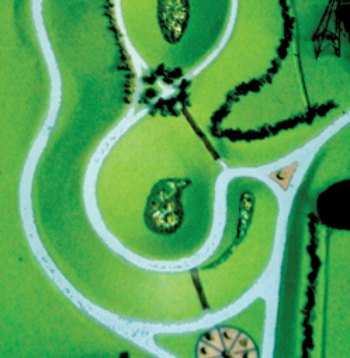 …and miniature golf courses…
…and miniature golf courses…
 …is the Links Invitational at the Kirkland Arts Center, curated by Cable Griffith. Twelve artists turned the galleries into 9 holes of playable golf, with courses running down the stairs, across a table top and through a passel of sturdy constructions.
…is the Links Invitational at the Kirkland Arts Center, curated by Cable Griffith. Twelve artists turned the galleries into 9 holes of playable golf, with courses running down the stairs, across a table top and through a passel of sturdy constructions.
Putt through the stove top into the sink, rattle through the pipes to land on the ground. If you’re going to get a hole in one, this is it. Ben Hirschkoff & Jason Wood, 7 Ways to Enjoy Washing the Dishes
 As Robert Morris liked to say, simplicity of shape does not equate to simplicity of experience. Jason Hirata, When I was in sixth grade, I designed a golf course for school
As Robert Morris liked to say, simplicity of shape does not equate to simplicity of experience. Jason Hirata, When I was in sixth grade, I designed a golf course for school
 Hirata, detail:
Hirata, detail:
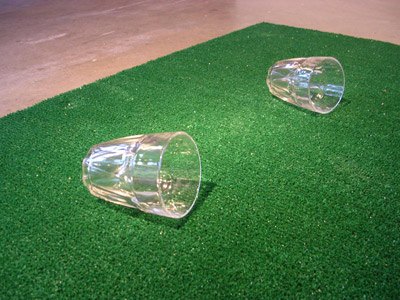 Drive low under cliches to rise through the hole: Kristen Ramirez, How Green Was My Valley
Drive low under cliches to rise through the hole: Kristen Ramirez, How Green Was My Valley
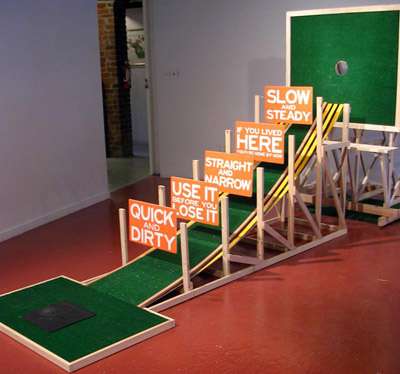 Tee off at the top of the stairs, bank left and free fall home: SuttonBeresCuller, Pigeonholed
Tee off at the top of the stairs, bank left and free fall home: SuttonBeresCuller, Pigeonholed
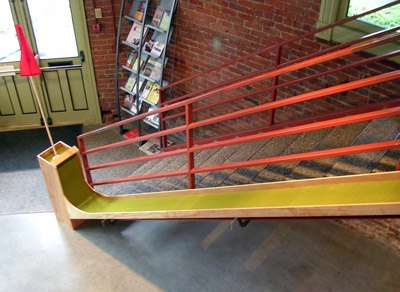 Through Thursday.
Through Thursday.
Reality TV: artists as female stereotypes
On all the reality shows remotely connected to art – Bravo’s Project Runway and Work of Art, So You Think You Can Dance on FOX – the judges are identified by full names, and the artists by first only. Why? The artists are the chicks, an idea reality TV did not invent. June Wayne explored the cute-little-artist theme in a 1973 essay titled Male Artist As Stereotypical Female, unfortunately not online.
I haven’t read it in years and don’t have a copy but remember it as conclusive. When Donald Kuspit claimed in a lecture in Seattle that artists create but need the intelligence of critics to animate that creation, he illustrated Wayne’s point exactly. Critics are male stereotypes, opening the door for the little lady.
Not to pick on Kuspit, but he tends to wade into his own muck and root around as if he’s dining with the queen. Take, for instance, his take on glass in his 1998 tome on Chihuly:
When it is soft, it can be identified as female, and when it is hard, as male.
The opposite, he wrote, is also true:
At the same time, when it is hard it is static, a trait often
traditionally considered female, and when it is soft it is dynamic,
supposedly a male trait.
Kuspit would be fun on Work of Art. When being fed nonsense, I prefer it to be elegant nonsense, like Kuspit’s. With the exception of the only-fleetingly-there Jerry Saltz, Work of Art judges tend to vacant.
They seem to believe that if artists can’t (or won’t) explain their work, that work can’t be valid. It’s the reason Nao Bustamante was axed from the shock-art episode, even though her piece was the only one that came close to shocking AND even though guest artist Andres Serrano tried to save her. (Judges who don’t listen to Serrano on this subject are beyond dim.)
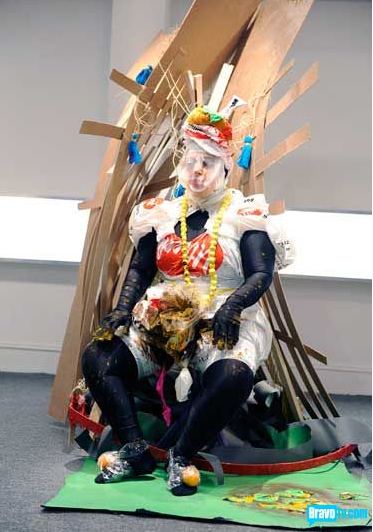 She sat amid her rubble like a demented street person, plucking at herself as judges discussed her. She lost the race because she could not keep so slow a pace. And because she refused to provide cue cards. As Dave Hickey put it:
She sat amid her rubble like a demented street person, plucking at herself as judges discussed her. She lost the race because she could not keep so slow a pace. And because she refused to provide cue cards. As Dave Hickey put it:
I don’t care about an artist’s intentions. I care if the work looks like it might have some consequences.
Bustamante had the best line on her reluctance to explain, from the first episode and now a t-shirt available via.
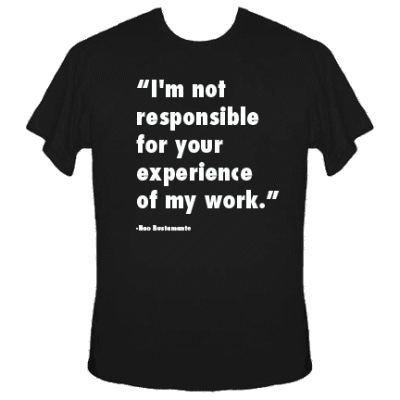 The judges aren’t the real problem with Work of Art. It’s a combination of weak challenges and too many weak artists. Apparently weak artists. Hard to say when given the odd glimpse of their artificially-produced output through a TV screen. Of the artists remaining, Peregrine Honig, Miles Mendenhal and Nicole Nadeau have managed to master the eccentric format. The rest are just puzzling.
The judges aren’t the real problem with Work of Art. It’s a combination of weak challenges and too many weak artists. Apparently weak artists. Hard to say when given the odd glimpse of their artificially-produced output through a TV screen. Of the artists remaining, Peregrine Honig, Miles Mendenhal and Nicole Nadeau have managed to master the eccentric format. The rest are just puzzling.
Back to Saltz for a second. His running commentary on the show is better than the show, although his foray into art-critic stand-up is worth watching on the screen. There’s the time he told guest artist Will Cotton that he was a girly-man (Only girls draw unicorns in their youths.) Cotton brushed him off with dignity. And there’s the time Saltz dipped into AA for art-crit lingo: “Keep it simple, stupid.” Yes, he’s flailing about, and his attempts to distance himself from the Work of Art herd don’t always ring true.
Saltz:
No one in the art world calls themselves a “figurative” or “abstract”
painter. They just say they’re an artist or a painter. It was a sign
that the producers didn’t know the art-world lingo.
No one uses the terms figurative or abstract? Saltz needs to tell his wife. She used the offending language in her recent obit on Doug Ohlson:
By the time Mr. Ohlson died on June 29 at 73, after a fall in front of
his loft building on Bond Street in Manhattan, he had fulfilled his
determination with considerable effectiveness, making abstract paintings
that experimented intuitively with the color spectrum regardless of
fashion.
Great obit, but I’ll bet the lead was ruined by some dead-literal editor. When I read it, I did not miss working at a newspaper. Remove the first five words, and the sentence is a winner.
It could be said that Doug Ohlson’s determination to be a painter came out of the blue.
Project Runway opens its eighth season on Thursday night. Its judges are far better than Work of Art‘s, and yet a tedium hangs over the enterprise. Its much-imitated format is now old hat. More importantly, uninspiring contestants in recent years haven’t offered much of a reason to care about them.
That leaves So You Think You Can Dance. Of the judges, Adam Shankman is both likable and savvy. The others are frequently intolerable. Nigel Lythgoe is a self-aggrandizing ass. Mia Michaels has virtues as a choreographer, but as a judge, she’s strictly from the feelings school, specializing in her own. Her praise curdles with emotional excess, and her criticisms are personal attacks.
As the show (slowly, grudgingly) gains legitimacy in the dance community, better choreographers are widening its reach, but what makes this show compelling is the dancers. Although it’s painful to watch them be milked like production-line cows, every week they turn whatever they’re given into gold.
About that production line: Three artists this season have been felled by injuries, including the brilliant Alex Wong, whose injury is serious enough to be career threatening. Each season dancers are asked to do more. Top cows at dairy farms are treated better. (On the link, Wong in a hip hop routine with tWitch. Below, with Allison Holker. Watch to the end and note that final step.)
Your eyes (on Seattle art blogs)
Peter Gabriel’s version, mutated to Seattle art blogs.
Shaun Kardinal on Translinguistic Other:
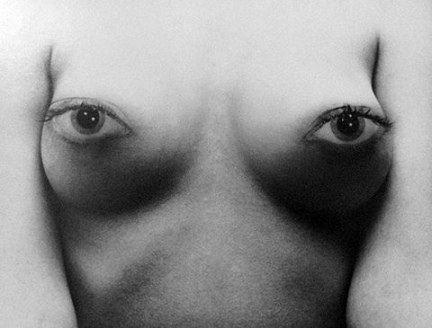 Andy Warhol, Ann Buchanan’s Screen Test on Best Of:
Andy Warhol, Ann Buchanan’s Screen Test on Best Of:
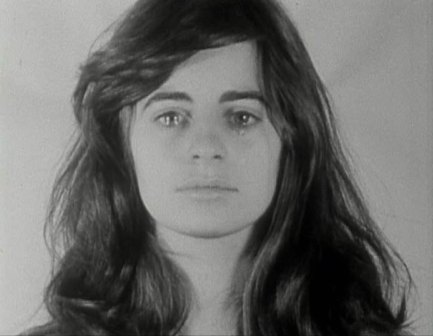 Joey Veltkamp on Best Of, deer, all the time, deer:
Joey Veltkamp on Best Of, deer, all the time, deer:
 Except, of course, for Joey, there are also bears. (Eye of ownership, eyes of ecstasy.) Joey on Getting to Know You Better:
Except, of course, for Joey, there are also bears. (Eye of ownership, eyes of ecstasy.) Joey on Getting to Know You Better:
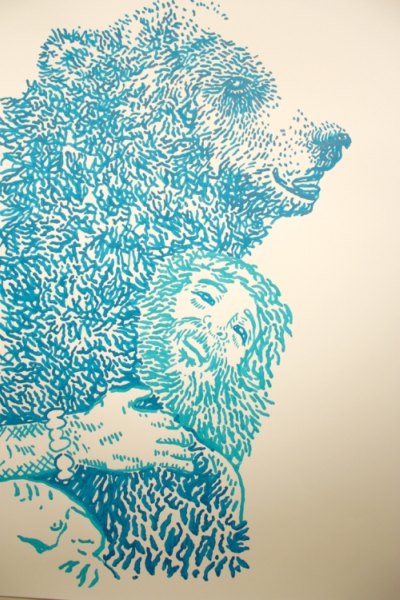 Staring over the burn: Ariana Page Russell on Getting To Know You Better:
Staring over the burn: Ariana Page Russell on Getting To Know You Better:
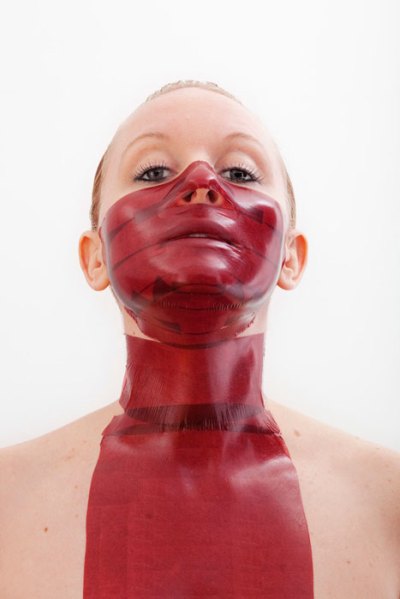 Staring at nothing: Diane Arbus on Jouissance:
Staring at nothing: Diane Arbus on Jouissance:
